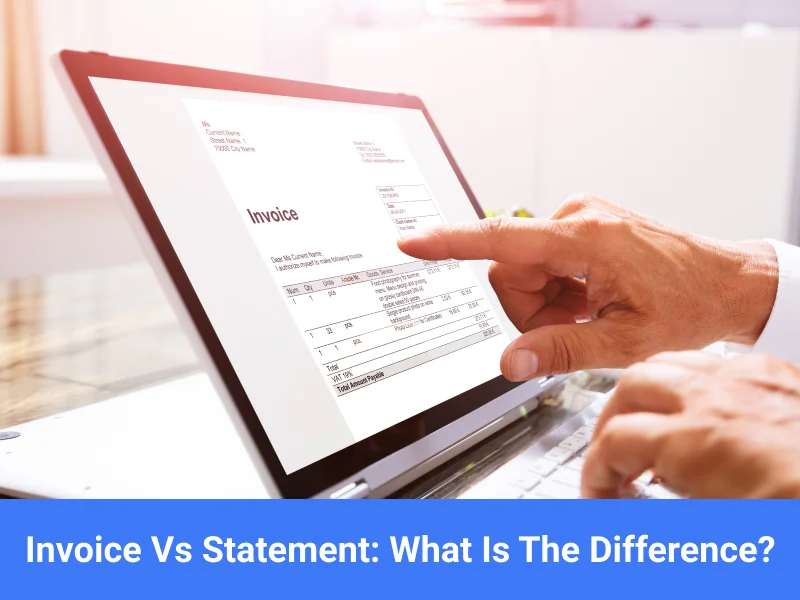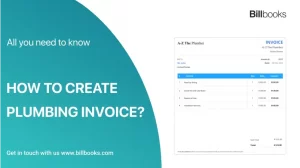Invoices and statements are those business financial documents that are commonly used by both small and large businesses in their day-to-day operations. An invoice is a payment request made by the vendor or the supplier after fulfilling the order. Whereas, the statement denotes the current status of the customer account.
Don’t you receive a monthly account statement from your bank? Same way business follows this method to keep the customer updated about the amount of money they still owe to the vendor.
So practically, an invoice is a request for payment and a statement is the status of the invoices for a particular customer.
In order to understand the differences between an invoice and a statement, let’s take up each point individually.
Let’s begin with:
What is an invoice?
An invoice is a legal document issued by the seller to the buyer to request payment after completing the task. An invoice can be generated either on a regular basis or on a contractual basis. There are quite a few different types of invoices that are required for specific purposes. Moreover, it helps track your expenses. Depending upon the status of the invoice it is tagged with ‘paid’, ‘outstanding’, or ‘overdue’, which may require sending payment reminders for recovering the due amount.
What is included in an invoice?
Being a vital financial document, it needs to be specific and accurate. Here’s what you need to add to an invoice:
- Business name, logo, address, and contact information
- Client information
- Invoice number
- Invoice date
- Itemized list of services or products provides
- Prices for each with the total amount
- Payment terms
- Payment method
Invoices are used by both small or large businesses. Besides requesting payment, invoices are a great tool for tracking or monitoring the financial record of your business that helps you while filing taxes or during audit trails. It also helps in invoice reconciliation to figure out the discrepancies in financial statements after any particular transaction.
Is invoice a financial statement?
Absolutely not! Both these documents are pretty different from the other. An invoice is a legal document that creates an obligation for the client to pay the due amount within the specified time frame. Whereas, statements present the transaction details between you and your clients during a specific time period.
Differences between invoice and other financial documents
The business implements various forms of documents while ordering products/services and invoicing. This section will give a better idea of how invoices differ from other types of documents
| Invoice | Purchase Order | Sales Order | Bill | |
| Meaning | As already discussed, an invoice is a legally binding document that requests payment after completing a specific task. | This is sent to initiate a transaction, which lets the supplier understand the requirements of the client. | This is another document that is sent in response to the purchase order and issued by the vendor. | Bill and invoice are quite synonymous, as an invoice issued is received as a bill by the customer. |
| Issued when | After completing the task or after fulfilling the order. | Issued before initiating the transaction. | Issued after receiving a purchase order. | Issued after order is fulfilled. |
Next start with,
What is a statement?
Statement plays a vital role in business finances. It is sent to highlight the status of the client’s account at a particular point in time. It is generally sent on a monthly basis and includes information like previous balance, invoice paid, or outstanding during the billing period. It also consists of the invoice number, date, and total invoices along with the time period an invoice is unpaid, payment terms and methods, etc. Well, a statement can be customized as per the client’s requirement. Some want only unpaid invoice status while some may prefer to see all transactions.
What is included in a statement?
So basically, a statement includes the following details:
- List of recent invoices with invoice details (invoice date, number, amount purchased, payment made, and balance outstanding)
- Customer information
- Seller information
- Statement date
- Statement record period
- Statement number
What are the uses of a statement?
Statements are quite significant for tracking business finances. It helps both the seller and the client to keep track of the account receivables and outstanding balances. It also proves to be an effective strategy when invoices go missing and helps to track overdue client accounts. The statement is an easy way to monitor incoming and outgoing money. Recording statements help in account bookkeeping also.
Is the statement a bill?
No, bills and statements are completely different from each other. Statement highlights the client’s account details for a specific period of time. While a bill is an invoice received at the customer’s end which is a request for payment.
Invoice vs Statement
The basic difference between statement and invoice lies in the intent. Invoice demands the payment the customer owes to the vendor. Whereas, the statement notifies the buyer about the overall outstanding receivables.
An invoice consists of details of a particular transaction. Whereas, a statement includes details of multiple invoices with their current status.
An invoice is issued after the completion of the project. While the statement is sent on a monthly basis highlighting the invoice data for a fixed time period.
| Invoice | Statement | |
| Purpose | An invoice is an official request for payment that highlights the amount for a specific service provided or product sold. | Whereas, a statement is another accounting document that records all the transactions in the account over a given period of time. |
| Information | The data list of invoices includes the 1. invoice date and number 2. seller and buyer contact details 3. Itemized list of products/services 4. Prices 5. Total amount 6. Payment due date 7. Terms and conditions | While the information in a statement is pretty different from that of the invoice. 1. Statement date 2. Record period 3. Seller and customer contact details 4. Invoice list with outstanding balance and other related information. |
| Frequency of receiving | Invoice is issued after task completion. The frequency of receiving invoices depends upon the client. If it is recurring then one might receive weekly/monthly/quarterly/yearly. | On the contrary, a statement is received at a fixed interval of time irrespective of task completion or any other parameters. |
| Outlook of the document | Invoice shares details of a single purchase. | The statement holds details of multiple purchases hence may look a bit overwhelming. |
Create Effective Invoices Seamlessly Within Seconds With Billbooks!
This online invoicing software allows you to generate professional invoices and also helps you to track your expenses smoothly. Try the free trial now!
Final thought!
Going back to follow up for every unpaid invoice or to record all paid invoices for a business is a tedious task. But monthly statements can make the jobs way more seamless, as it shares an overview of the balance due. Therefore, both these documents are quite different from each other through both of these make bookkeeping much easier for your business.



